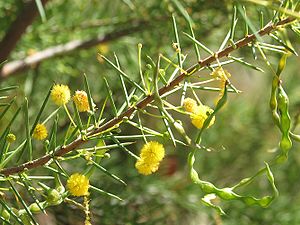Acacia tetragonophylla
| Acacia tetragonophylla | ||||||||||||
|---|---|---|---|---|---|---|---|---|---|---|---|---|

Acacia tetragonophylla |
||||||||||||
| Systematics | ||||||||||||
|
||||||||||||
| Scientific name | ||||||||||||
| Acacia tetragonophylla | ||||||||||||
| F. Garbage. |
Acacia tetragonophylla even curare , Kurara or English: Dead Finish called, is a plant from the family of legumes (Fabaceae). It iswidespreadin Australia .
description
Vegetative characteristics
Acacia tetragonophylla grows as a large shrub or small tree that usually reaches heights of 2 to 5 meters. The branches are often tangled and overgrown. The bark of the branches is bare.
From a botanical point of view, the needle-like “leaves” are phyllodes . The phyllodes usually sit in groups of two to six in groups (bundles) on compact side branches or individually on young branches. With a length of usually 1 to 5 cm and a width of about 1 mm , the phyllodes are linear- submerged , pentagonal to flattened in cross-section, with the upper end ending in a stiff, thin, bald tip that is 1 to 2 mm long. The phyllodes have five or rarely seven very raised nerves and are furrowed when dry. Initially the phyllodes are still soft and pliable, later they become hard, stiff and very sharp.
Generative characteristics
In the leaf axils there are one to five individual inflorescences on 1 to 3 cm long, bare inflorescence shafts. 50 to 90 flowers are arranged in spherical inflorescences . The hermaphrodite, golden-yellow flowers are five-fold. The free sepals are linear-spatulate .
With a length of up to 10 cm and a width of 4 to 6 mm, the bare, almost woody to leathery legume is curved to open and screwed one and a half times and often twisted along the seams. The legume is raised above the seeds and slightly to prominently constricted between them. The longitudinal seeds are elliptical with a length of 4 to 5.5 mm. The light yellow funiculus circles the seed.
Chromosome number
The number of chromosomes is 2n = 26.
Occurrence
The vast Australian range of Acacia tetragonophylla includes northwestern and north-central New South Wales , southern Northern Territory , southwest Queensland , South Australia and Western Australia . Acacia tetragonophylla thrives on floodplains and along watercourses in arid and semi-arid areas.
Systematics
The first description of acacia tetragonophylla in 1859 by Ferdinand von Mueller in Contributiones ad Acaciarum Australiae cognitionem. Journal of the Proceedings of the Linnean Society, Botany , Volume 3, p. 121. The specific epithet tetragonophylla is composed of the Greek words tetra for four, gonia for edge and phyllo , phyllon for leaf, leaflet. Synonyms for Acacia tetragonophylla F.Muell. are Acacia genistoides A.Cunn. ex Benth. , Racosperma tetragonophyllum (F.Muell.) Pedley .
Acacia tetragonophylla belongs to the subgenus Phyllodineae in the genus Acacia .
Ethnobotany
Acacia tetragonophylla is used to treat warts . Several of the needle-shaped leaves are pricked into the wart, leaving the tips and breaking off the rest of the needle. After four or five days, the wart will have shrunk and can be removed.
literature
- AA Mitchell, DG Wilcox: Arid Shrubland Plants of Western Australia . Second and Enlarged Edition, University of Western Australia Press, Nedlands, Western Australia 1994, ISBN 1-875560-22-X .
- John Pearn: Medical Ethnobotany of Australia. Past and Present. In: The Linnean. Newsletter and Proceedings of the Linnean Society of London. Vol. 21, No. 4, Burlington House, Piccadilly, London, October 2005, pp. 16-24 (English, digitized , accessed on August 19, 2012).
Individual evidence
- ↑ a b c d e f g Entry in the Flora of Australia Online .
- ↑ Acacia tetragonophylla at Tropicos.org. In: IPCN Chromosome Reports . Missouri Botanical Garden, St. Louis
- ^ A b Acacia tetragonophylla in the Germplasm Resources Information Network (GRIN), USDA , ARS , National Genetic Resources Program. National Germplasm Resources Laboratory, Beltsville, Maryland.
- ↑ a b Entry in Australian Plant Name Index = APNI .
- ^ Entry in Australian Plants Online .
- ↑ "The sharp phyllodes of Acacia tetragonophylla (“ Dead Finish ”) are used to pierce warts. Botanists working in the Aputula Community of Central Australia have documented that:“ A number of [Acacia tetragonophylla] phyllodes may be inserted into the wart, the main part then being broken off to leave the apices embedded in the wart. After four or five days the wart has shriveled and may be removed easily "(John Pearn: Medical Ethnobotany of Australia. Past and Present . S. 21 Metro Trees ( Memento from October 19, 2011 in the Internet Archive ))
